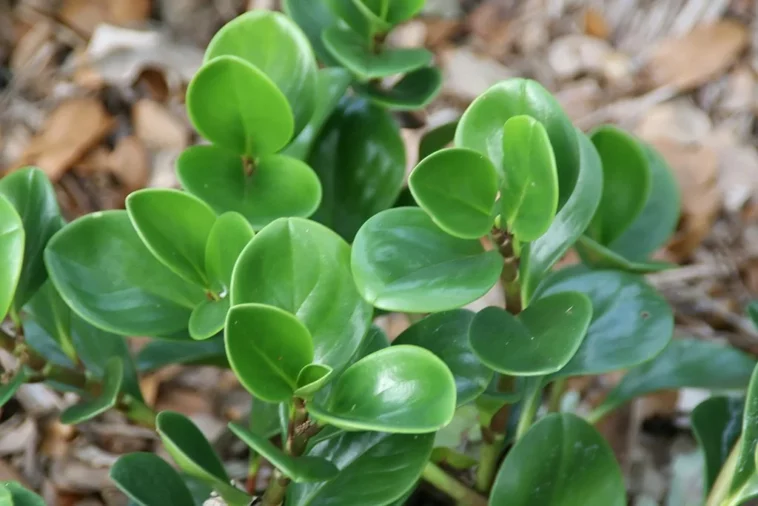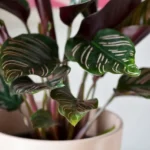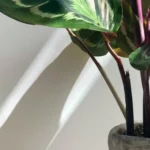Table of Contents
Caring for a Baby Rubber Plant
The baby rubber plant, or Peperomia obtusifolia, is also known as the American rubber plant. It’s native to Florida, Central America, and South America.
It’s popular partially because it looks a lot like a succulent but is not actually a succulent. It’s compact, with a small root system, and it has comparatively large, shiny, green leaves.
Some varieties of the baby rubber plant have variegated leaves, which gives them some yellow or white in addition to the green.
The baby rubber plant is popular for its thick, green leaves and also for its ease of care. When pruned as needed, this plant does well staying about a foot tall by a foot wide.
It makes for a neat, pretty little plant that doesn’t take a lot of effort. It’s also a great choice for someone who hasn’t cared for plants before.
Helping Your Baby Rubber Plant Thrive
Baby rubber plants are relatively easy to care for. It can survive most indoor conditions, However, it does have certain conditions it likes better than others.
It’s good to provide the baby rubber plant with what it wants, but it’s not likely to die at the slightest variation.
As a tropical plant, the baby rubber plant likes a warm, humid climate best, but it’s more tolerant of dryness than a lot of other tropical plants.
It can also deal with a wider range of lighting than most tropical plants without suffering, although the requirements are a little more strict with variegated types of baby rubber plants.
Keep an eye on the leaves for signs that the plant is not thriving. If the leaves start showing discoloration, drooping or wilting, burning or fading, then chances are good that it needs a little bit of an adjustment.
Light Requirements
The baby rubber plant does best with medium to bright but indirect light. If you live in a cooler climate, the variegated baby rubber plants can even do well with a little bit of direct light, especially in mornings when it’s weaker.
On the dim end of the light spectrum, baby rubber plants have even been known to do well in fluorescent lighting.
If you have a variegated plant that starts to lose its color variation, this means it probably needs more light.
If the tips of your plant start looking burnt or the leaves look faded, it’s probably getting a bit too much direct light.
Temperature Requirements
The baby rubber plant likes temperatures between 65 and 75 degrees Fahrenheit. However, if you’re comfortable in your house, the plant probably will be, too. This is one of the reasons tropical plants make such great houseplants.
Soil Requirements
The baby rubber plant has a small root system and is a tropical plant, both of which mean it likes moist soil but doesn’t tolerate soil that is too wet. It does well with a mix of peat and perlite, but any well-aerated, well-draining soil will work without any problems.
Be sure that the pot has ample drainage and that any drainage routes remain unblocked.
Humidity Requirements
This plant enjoys high humidity, but it can do well in average humidity, and some plant parents even report that it does well in dry climates.
You can try misting the baby rubber plant in between waterings, or if the plant seems really dried out and is getting enough water via soil, consider increasing the ambient humidity by setting out some water or by providing a humidifier.
How to Water Your Baby Rubber Plant
The baby rubber plant needs to be watered about once a week. This can vary based on climate and season; plants generally need less water in winter and need more water in hot, arid climates.
To avoid overwatering your baby rubber plant, make sure the top inch or two of soil is dry before watering again. If the leaves start drooping and losing leaves, that can indicate that the plant is getting too much water.
You may find that your baby rubber plant only needs to be watered every two weeks, especially in winter.
How to Fertilize Your Baby Rubber Plant
The baby rubber plant needs little to no fertilizer. If you choose to fertilize, do so monthly during spring and summer, with a fertilizer diluted by half.
Pruning Your Baby Rubber Plant
The baby rubber plant won’t suffer if it isn’t pruned regularly. However, it sometimes gets a little shaggy or too big for its intended cute, upright appearance, and pruning can help in both of these situations.
Propagation of Your Baby Rubber Plant
The best method for propagation of a baby rubber plant is to take a cutting. Cut at the stem, making sure there are at least two leaves on the cutting, and clipping an inch or two below where a leaf joins the stem.
Plant this in a small pot with moist soil, and provide it with a warm, humid climate and bright, indirect light. Give it a little extra care until it has taken root.
Pests and Diseases
Baby rubber plants aren’t really prone to any diseases. They do occasionally attract mealybugs or spider mites.
Ridding Your Baby Rubber Plant of Pests
If you see signs of infestation, such as seeing actual bugs or webs, then manually remove all traces of pests and their webs by wiping them down with a damp cloth.
Then, treat the plant with a mild insecticide or neem oil. Be sure to check any nearby plants in case the infestation spread.
Toxicity
The baby rubber plant is non-toxic, which makes it a good choice if you have pets or small children. Of course, it isn’t good for the plant to be eaten, so despite its being non-toxic, it’s generally a good idea to keep the baby rubber plant where it won’t be consumed.
Quick Reference
- Light: Medium to bright, indirect
- Temperature: 65-75 degrees Fahrenheit
- Soil: Peat and perlite
- Humidity: Average to high
- Water: Weekly or less, when top 1-2 inches of soil is dry
- Pruning: As needed for aesthetics or to keep compact
Photo by David J. Stang, CC BY-SA 4.0 https://creativecommons.org/licenses/by-sa/4.0, via Wikimedia Commons


